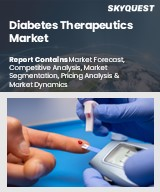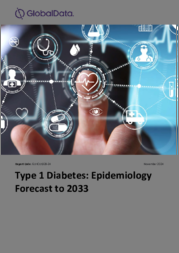
|
시장보고서
상품코드
1635622
1형 당뇨병(T1D) : 7개 시장 의약품 예측과 시장 분석Type 1 Diabetes: Seven-Market Drug Forecast and Market Analysis |
||||||
주요 7개 시장 전체 T1D 치료제 시장 규모는 2023년 약 28억 3,000만 달러로 추정되며, 2033년까지 T1D 시장은 연평균 13.3%의 높은 성장률을 보이며 예측 기간 말에는 99억 1,000만 달러에 달할 것으로 예상됩니다.
예측 기간 동안 T1D 시장 성장의 주요 촉진요인은 다음과 같습니다.
- 인슐린 펌프 사용 증가에 따른 속효성 인슐린 처방 증가 추세
- 경구제 및 주사제 출시, 특히 면역 조절 요법
- 전 세계 T1D 유병률 증가
예측 기간 동안 T1D 시장의 성장을 저해하는 주요 장벽은 다음과 같습니다.
- 특정 인슐린 제제 및 면역 조절 약물의 높은 가격
- 바이오시밀러와 제네릭의 추가 침식을 가능하게 하는 특허 만료
- 질병 개량 신약 개발 임상시험의 높은 실패율
본 보고서는 1형 당뇨병(T1D)의 주요 7개국(미국, 유럽 5개국, 일본)에 대해 조사했으며, 질환 개요, 시장 매출 및 예측, 파이프라인 분석, 현재 및 향후 경쟁 분석 등의 정보를 전해드립니다.
목차
제1장 1형 당뇨병 : 주요 요약
- 1형 당뇨병 치료제 시장 규모는 2033년까지 99억 1,000만 달러에 이릅니다.
- 제1형 당뇨병 시장의 선두주자들은 바이오시밀러의 위협으로부터 인슐린 프랜차이즈를 보호하기 위해 다양한 전략을 채택하고 있으며, 신생기업들은 질병 변형 혁신에 초점을 맞추고 있습니다.
- 현재 T1D 치료와 새로운 T1D 치료의 간극을 보여주는 미충족 수요는 여전히 존재하고 있습니다.
- 제1형 당뇨병 관리에서 펌프, CGM 및 초속효성 인슐린의 시너지 효과
- 의사의 생각
제2장 소개
제3장 질환 개요
- 병인과 병태생리학
- 병인
- 병태생리학
- 1형 당뇨병의 췌도 자가 반응성을 모니터링하는 바이오마커
제4장 역학
- 질환 배경
- 위험인자와 합병증
- 세계의 과거 동향
- 주요 7개 시장 예측 방법
- 1형 당뇨병 역학 예측(2023-33년)
- 1형 당뇨병 환자 수
- 1형 당뇨병 환자 수 : 연령별
- 1형 당뇨병 환자 수 : 성별
- 1형 당뇨병 환자 수 : BMI 카테고리별
- 저혈당을 경험한 1형 당뇨병 환자 수
- 불안정형 당뇨병을 수반하는 1형 당뇨병 환자 수
- DKA 사상을 경험한 T1D 환자 수
- 췌장 이식 대상이 되는 1형 당뇨병 환자 수
- CKD를 수반하는 T1D 환자 수
- CVD를 수반하는 T1D 환자 수
- HLA-DQ8를 코딩하는 유전자를 적어도 하나 이상 가지고 있는 1형 당뇨병 환자 수
- 1형 당뇨병 총 유병자수
- 논의
- 역학 예측 인사이트
- COVID-19의 영향
- 분석의 한계
- 분석의 강점
제5장 질병 관리
- 진단과 치료 개요
- 미국의 질병 관리
- 유럽 5개국의 질병 관리
- 일본의 질병 관리
- 질병 관리에 관한 KOL의 인사이트
제6장 현재 치료 옵션
- 개요
제7장 미충족 수요와 기회 평가
- 개요
- 질환 조절 치료의 절실한 필요성
- 저혈당 발작 회피와 혈당 컨트롤 최적화
- 컴플라이언스 향상과 인슐린 요법의 부담 경감
- 1형 당뇨병 관리에 드는 높은 비용
제8장 연구개발 전략
- 개요
- 면역조절 요법 : 자가면역 병태에 대한 대처
- 첨단 약물전달 시스템과 글루코스 응답성 인슐린
- 재생의료 : 치유적 요법 추구
- 임상시험 설계
- 연구 디자인 - 적응형 임상시험과 종합적인 프레임워크
- 디지털 헬스의 통합
- 모델 기반 시뮬레이션
제9장 파이프라인 평가
- 개요
- 임상 개발중인 유망한 의약품
제10장 파이프라인 평가 분석
- 개요
- 경쟁 평가
- 인슐린 요법
- 인슐린 이외 치료법
제11장 현재 기업과 향후 기업
- 개요
- 거래 동향
제12장 시장 전망
- 세계 시장
- 예측
- 성장 촉진요인과 장벽 - 세계의 문제
- 미국
- 예측
- 주요 사건
- 성장 촉진요인과 장벽
- 유럽연합
- 예측
- 주요 사건
- 성장 촉진요인과 장벽
- 일본
- 예측
- 주요 사건
- 성장 촉진요인과 장벽
제13장 부록
ksm 25.02.14This report covers the 7MM (US, France, Germany, Italy, Spain, UK, Japan) and provides an Excel-based forecast model for the type 1 diabetes market through 2033.
GlobalData estimates sales of T1D therapeutics to be approximately $2.83 billion across the 7MM in 2023. By 2033, GlobalData expects the T1D market to grow at a strong compound annual growth rate (CAGR) of 13.3%, reaching sales of $9.91 billion by the end of the forecast period.
Major drivers of T1D market growth over the forecast period are the -
- Increase in the prescription of rapid-acting insulins in line with rising use of insulin pumps
- Launch of several oral and injectable agents, particularly immunomodulatory therapies
- Increase in the global prevalence of T1D
Major barriers that will restrict the growth of the T1D market during the forecast period are the -
- High price of certain insulins and immunomodulatory agents
- Patent expiries allowing for further biosimilar and generic erosion
- High failure rate of clinical trials developing disease-modifying therapeutics
Scope
- Overview of type 1 diabetes, including epidemiology, symptoms, diagnosis, and disease management.
- Annualized type 1 diabetes therapeutics market revenue, cost of therapy per patient, and treatment usage patterns forecast from 2023 to 2033.
- Key topics covered include strategic competitor assessment, market characterization, unmet needs, clinical trial mapping, and implications of these factors for the type 1 diabetes therapeutics market.
- Pipeline analysis: comprehensive data assessing emerging trends and mechanisms of action under development for type 1 diabetes treatment. The most promising candidates in late-stage development are profiled.
- Analysis of the current and future market competition in the global type 1 diabetes therapeutics market. Insightful review of the key industry drivers, restraints and challenges. Each trend is independently researched to provide qualitative analysis of its implications.
Reasons to Buy
- Develop and design your in-licensing and out-licensing strategies through a review of pipeline products and technologies, and by identifying the companies with the most robust pipeline.
- Develop business strategies by understanding the trends shaping and driving the 7MM type 1 diabetes therapeutics market.
- Drive revenues by understanding the key trends, innovative products and technologies, market segments, and companies likely to impact the 7MM type 1 diabetes therapeutics market in the future.
- Formulate effective sales and marketing strategies by understanding the competitive landscape and by analyzing the performance of various competitors.
- Identify emerging players with potentially strong product portfolios and create effective counter-strategies to gain a competitive advantage.
- Organize your sales and marketing efforts by identifying the market categories and segments that present maximum opportunities for consolidations, investments and strategic partnerships.
Table of Contents
Table of Contents
1 Type 1 Diabetes: Executive Summary
- 1.1 Type 1 Diabetes therapeutics market will grow to $9.91 billion by 2033
- 1.2 T1D market leaders employ diverse strategies to protect insulin franchises from biosimilar threats, while emerging players focus on disease-modifying innovations
- 1.3 Persistent unmet needs highlight gaps in current and emerging T1D therapies
- 1.4 The synergistic rise of pumps, CGMs, and ultra-rapid-acting insulins in T1D management
- 1.5 What do physicians think?
2 Introduction
- 2.1 Catalyst
- 2.2 Related reports
- 2.3 Upcoming reports
3 Disease Overview
- 3.1 Etiology and pathophysiology
- 3.1.1 Etiology
- 3.1.2 Pathophysiology
- 3.1.3 Biomarkers for monitoring the islet autoreactivity of T1D
4 Epidemiology
- 4.1 Disease background
- 4.2 Risk factors and comorbidities
- 4.3 Global and historical trends
- 4.4 7MM forecast methodology
- 4.4.1 Sources
- 4.4.2 Forecast assumptions and methods
- 4.4.3 Forecast assumptions and methods: diagnosed prevalent cases of T1D - 7MM
- 4.4.4 Forecast assumptions and methods: diagnosed prevalent cases of T1D
- 4.4.5 Diagnosed prevalent cases of T1D segmented by BMI
- 4.4.6 Diagnosed prevalent cases of T1D that experienced hypoglycemic events
- 4.4.7 Diagnosed prevalent cases of T1D with brittle diabetes
- 4.4.8 Diagnosed prevalent cases of T1D that experienced DKA events
- 4.4.9 Diagnosed prevalent cases of T1D eligible for pancreas transplantation
- 4.4.10 Diagnosed prevalent cases of T1D with CKD
- 4.4.11 Diagnosed prevalent cases of T1D with CVD
- 4.4.12 Diagnosed prevalent cases of T1D with at least one gene encoding for HLA-DQ8
- 4.4.13 Forecast assumptions and methods: total prevalent cases of T1D
- 4.5 Epidemiological forecast for T1D (2023-33)
- 4.5.1 Diagnosed prevalent cases of T1D
- 4.5.2 Age-specific diagnosed prevalent cases of T1D
- 4.5.3 Sex-specific diagnosed prevalent cases of T1D
- 4.5.4 Diagnosed prevalent cases of T1D by BMI category
- 4.5.5 Diagnosed prevalent cases of T1D that experienced hypoglycemic events
- 4.5.6 Diagnosed prevalent cases of T1D with brittle diabetes
- 4.5.7 Diagnosed prevalent cases of T1D that experienced DKA events
- 4.5.8 Diagnosed prevalent cases of T1D eligible for pancreas transplantation
- 4.5.9 Diagnosed prevalent cases of T1D with CKD
- 4.5.10 Diagnosed prevalent cases of T1D with CVD
- 4.5.11 Diagnosed prevalent cases of T1D with at least one gene encoding for HLA-DQ8
- 4.5.12 Total prevalent cases of T1D
- 4.6 Discussion
- 4.6.1 Epidemiological forecast insight
- 4.6.2 COVID-19 impact
- 4.6.3 Limitations of the analysis
- 4.6.4 Strengths of the analysis
5 Disease Management
- 5.1 Diagnosis and treatment overview
- 5.2 US disease management
- 5.3 5EU disease management
- 5.4 Japan disease management
- 5.5 KOL insights on disease management
6 Current Treatment Options
- 6.1 Overview
7 Unmet Needs and Opportunity Assessment
- 7.1 Overview
- 7.2 Urgent need for disease-modifying therapies
- 7.3 Avoiding hypoglycemic episodes and optimising glycemic control
- 7.4 Improving compliance and reducing the burden of insulin therapy
- 7.5 High financial cost of T1D management
8 R&D Strategies
- 8.1 Overview
- 8.1.1 Immunomodulatory therapies: addressing autoimmune pathogenesis
- 8.1.2 Advanced drug delivery systems and glucose-responsive insulins
- 8.1.3 Regenerative medicine: pursuing curative therapies
- 8.2 Clinical trials design
- 8.2.1 Study design - adaptive clinical trials and comprehensive frameworks
- 8.2.2 Digital health integration
- 8.2.3 Model-based simulations
9 Pipeline Assessment
- 9.1 Overview
- 9.2 Promising drugs in clinical development
10 Pipeline Valuation Analysis
- 10.1 Overview
- 10.2 Competitive assessment
- 10.2.1 Insulin therapies
- 10.2.2 Non-insulin therapies
11 Current and Future Players
- 11.1 Overview
- 11.2 Deal-making trends
12 Market Outlook
- 12.1 Global markets
- 12.1.1 Forecast
- 12.1.2 Drivers and barriers - global issues
- 12.2 US
- 12.2.1 Forecast
- 12.2.2 Key events
- 12.2.3 Drivers and barriers
- 12.3 EU
- 12.3.1 Forecast
- 12.3.2 Key events
- 12.3.3 Drivers and barriers
- 12.4 Japan
- 12.4.1 Forecast
- 12.4.2 Key events
- 12.4.3 Drivers and barriers
13 Appendix
- 13.1 Bibliography
- 13.2 Abbreviations
- 13.3 Methodology
- 13.3.1 Forecasting methodology
- 13.4 Primary research - KOLs interviewed for this report
- 13.4.1 KOLs
- 13.5 Primary research - prescriber survey
- 13.6 About the authors
- 13.6.1 Analyst
- 13.6.2 Therapy Area Director
- 13.6.3 Vice President of Disease Intelligence and Epidemiology
- 13.6.4 Global Head of Pharma Research, Analysis, and Competitive Intelligence
- About GlobalData
- Contact Us

















